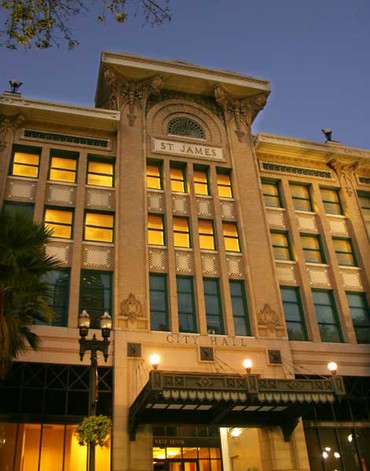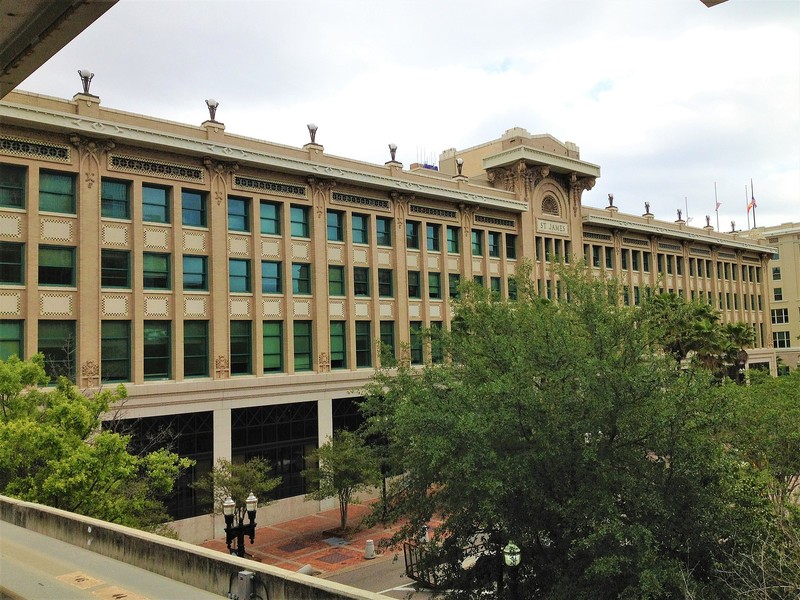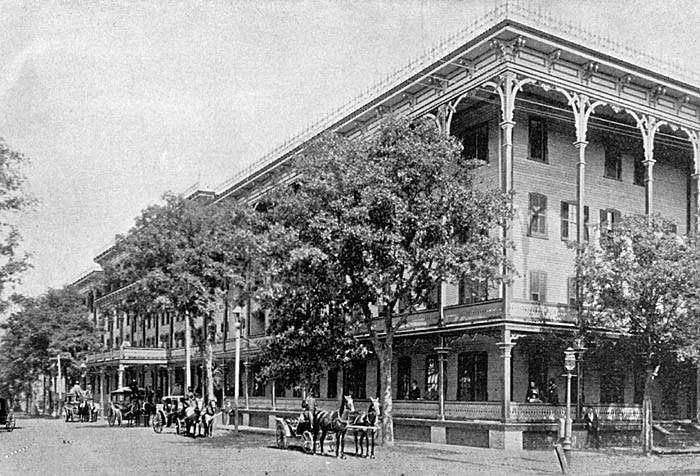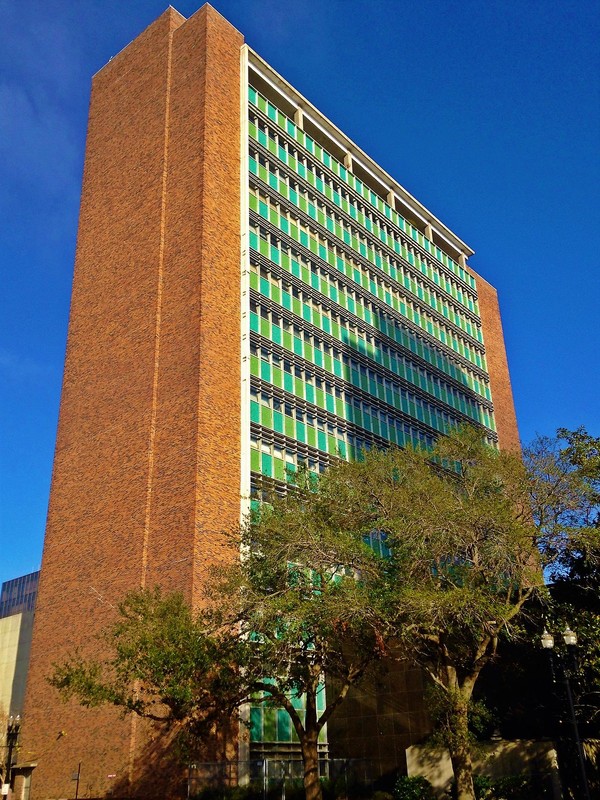Jacksonville City Hall
Introduction
Text-to-speech Audio
Images
City Hall at its current location in the St. James building.

The St. James building, where Jacksonville City Hall is currently located.

The St. James Hotel, 1893.

City Hall Annex, site of the former City Hall before its 2019 demolition.

The City Hall Annex falling during its 2019 demolition.

Backstory and Context
Text-to-speech Audio
Jacksonville City Hall once stood at a different location, 220 E. Bay Street, on 2.39 acres of land. The building, designed by the architectural firm Reynold, Smith & Halls, was erected in 1960, and was 228,000 square feet. For its time period, the building was considered advanced in its technologies. It included four high-speed elevators and was completely air-conditioned, also being constructed to be fireproof. It towered 15 stories high, with the north and south sides covered in aluminum frames and cast concrete spandrels with mosaic tiles made of Venetian glass.
Despite its beauty and usefulness, in 1997, a majority of the legislative and executive offices moved from that location to their current site, the St. James building. It left just several departments in the old City Hall, such as the State Attorney’s Office, until 2015, when they were also relocated to the old federal courthouse building. It officially closed in 2017. Afterward, city officials moved forward with plans to revitalize the riverfront, moving government buildings elsewhere to make room for more profitable development of private properties, which also included the Duval County Courthouse, since its operations had moved in 2012. The plans, however, began years earlier, when the Hyatt Regency Riverfront was built on what was once a parking lot for the old City Hall in 2001.
In the 2017-18 Capital Improvement Program Budget, Mayor Lenny Curry set aside $8 million for both the City Hall and courthouse projects. In August, the contractor Environmental Holdings Group LLC from Mooresville, North Carolina, began preparing the site of the old City Hall for a massive demolition. Preparation included removing asbestos, fixtures, and furniture, and access to surrounding streets and a portion of the St. Johns River were closed before and after the demolition. The nearby Hyatt Regency, however, was able to remain open. In November, the city received permits for the $4.95 million demolition of City Hall and the $3 million demolition of the courthouse. On January 20, 2019, the 59-year-old City Hall structure was removed via explosives in under 10 seconds. Next door, the 63-year-old courthouse was taken down conventionally.
While the city was still cleaning the demolition and making plans for the future of the 8.4 acres that were then available on the riverfront, City Hall operations had already been underway for years at the St. James building. The building was originally the St. James Hotel, which opened in 1869 and was the largest hotel in the Southeast and the largest building in Jacksonville at that time. In front of the hotel was also the city’s first park, called the St. James Park before being renamed to Hemming Park, then James Weldon Johnson Park. However, the Great Fire of 1901 that destroyed most of the city also burned the hotel with it. In 1912, Henry J. Klutho, an architect who moved to Jacksonville for work after the fire, rebuilt the St. James. It became the Cohen Brothers Store, later known as May-Cohens, before City Hall operations moved there in 2012. Initially, the building was meant to be two stories, with a balcony wrapping around it. Klutho, however, convinced the owners of the property that adding two more stories for office spaces would make it a place not only of shopping, but of business as well.
The building was worth $1 million, and had minor alterations done to both the interior and exterior over the years. According to work permits, in 1959, 1961, and/or 1969 the exterior of the first floor was covered with a layer of texturized concrete coating to give the St. James a more modern look. The most extensive work took place in 1947 by the architectural-engineering firm W. Kenyon Drake and Associates, during which time escalators were installed, a large octagonal dome over the third floor was removed, the open area it occupied on the fourth floor was filled in, and the Church Street elevation was walled up to the fourth floor’s roof line. Throughout remodels, most of the original interior decoration, such as the brass elevator cages, were lost. The St. James is now listed on the National Register of Historic Places.
Sources
- Taylor, Jr., George Lansing. St. James Building, Jacksonville, FL, University of North Florida. December 23rd 2009. Accessed October 21st 2020. https://digitalcommons.unf.edu/historical_architecture_main/2625/.
- Bailey, Emily. After nearly 60 years, Jacksonville’s old City Hall comes tumbling down, Jacksonville Magazine. March 7th 2019. Accessed October 21st 2020. https://www.jacksonvillemag.com/2019/03/07/jacksonvilles-old-city-hall/.
- City Hall, Downtown Jacksonville. Accessed October 21st 2020. https://downtownjacksonville.org/poi/city-hall/.
- Mathis, Karen Brune. The 15-story, 200,140-square-foot structure at 220 E. Bay St. Downtown comes down in less than 10 seconds to make way for future development., Jacksonville Daily Record. Accessed October 21st 2020. https://www.jaxdailyrecord.com/photo-gallery/it-belongs-to-the-ages--former-city-hall-annex-imploded.
- St. James Building, 117 West Duval Street, Jacksonville, Duval County, FL, Library of Congress. Accessed October 21st 2020. https://www.loc.gov/item/fl0266/.
- Historic American Building Survey, Library of Congress. Accessed October 21st 2020. http://lcweb2.loc.gov/master/pnp/habshaer/fl/fl0200/fl0266/data/fl0266data.pdf.
- St. James Hotel - Jacksonville, Florida., Florida Memory. Accessed October 21st 2020. https://www.floridamemory.com/items/show/142213.
https://www.coj.net/departments/public-affairs/photo-archive/photo-city-hall.aspx
https://commons.wikimedia.org/wiki/File:Jacksonville_City_Hall.JPG
https://fcit.usf.edu/florida/photos/cities/jax/jax2/jax214.htm
https://en.wikipedia.org/wiki/City_Hall_Annex_(Jacksonville,_Florida)
https://www.jacksonvillemag.com/2019/03/07/jacksonvilles-old-city-hall/
